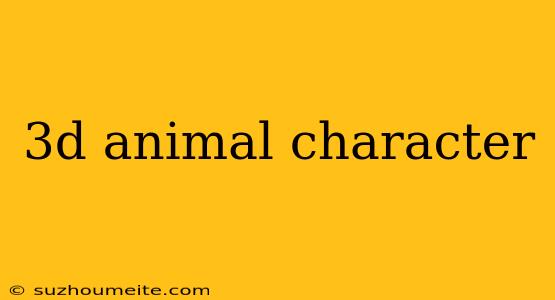Creating 3D Animal Characters: A Comprehensive Guide
Introduction
In the world of computer-generated imagery (CGI), 3D animal characters have become an essential aspect of animation, film, and video games. These characters not only bring stories to life but also evoke emotions and create a sense of realism. In this article, we will delve into the process of creating 3D animal characters, covering the basics, software, and techniques used in the industry.
Understanding the Basics
Anatomy and Proportion
Before diving into the 3D modeling process, it's essential to have a solid understanding of animal anatomy and proportion. Study the animal's skeletal structure, muscle mass, and facial features to ensure accuracy and realism. Proportion is crucial, as it affects the character's overall appearance and believability.
Reference Gathering
Collect reference images and videos of the desired animal to understand its behavior, movements, and expressions. This will help in creating a more authentic and engaging character.
Software and Tools
3D Modeling Software
Popular 3D modeling software used in the industry include:
- Blender: A free, open-source software ideal for beginners and professionals alike.
- Autodesk Maya: A powerful, industry-standard software used in film, television, and video games.
- 3ds Max: A commercial software commonly used in architectural visualization and product design.
Texturing and Shading
Substance Painter and Quixel Suite are popular tools used for texturing and shading 3D models. These software allow for detailed, realistic texture creation and material definition.
Techniques and Tips
Modeling Techniques
- Polycount: Control the number of polygons in your model to achieve the desired level of detail and efficiency.
- UV Unwrapping: Unwrap your model's UVs to create a 2D representation of the 3D object, allowing for easier texturing and shading.
- Topology: Focus on creating a clean, organized topology to ensure smooth deformations and animations.
Animation and Rigging
- Rigging: Create a skeleton for your character, allowing for realistic movements and deformations.
- Keyframe Animation: Use keyframe animation to create realistic movements and expressions.
- Physics-Based Simulation: Use simulation tools to create realistic simulations of hair, fur, and clothing.
Best Practices and Challenges
Keep it Simple
Avoid over-detailing your model, as it can lead to performance issues and complexity.
Reference, Reference, Reference
Continuously gather reference materials to ensure accuracy and authenticity.
Practice and Experimentation
Experiment with different techniques and software to find what works best for you.
Conclusion
Creating 3D animal characters requires patience, dedication, and practice. By understanding the basics, using industry-standard software, and applying techniques and tips, you can bring your characters to life. Remember to continuously learn, reference, and experiment to create believable and engaging 3D animal characters.
